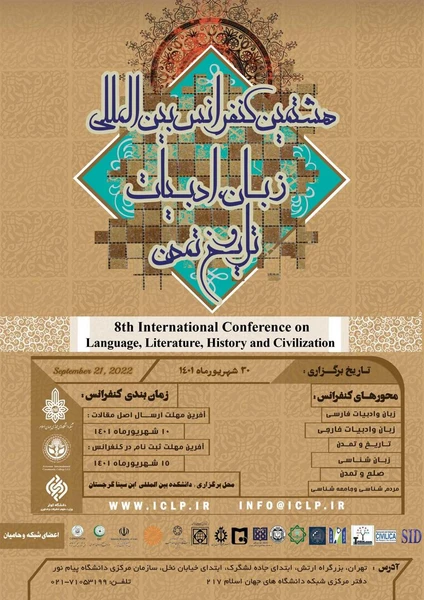-
comparing jami's "salámán and absál" with nizami’s "good and evil "stories based on jung's archetypes
جزئیات بیشتر مقاله- تاریخ ارائه: 1401/06/15
- تاریخ انتشار در تی پی بین: 1401/08/07
- تعداد بازدید: 95
- تعداد پرسش و پاسخ ها: 0
- شماره تماس دبیرخانه رویداد: 02171053199
comparing jami's "salámán and absál" with nizami’s "good and evil "stories based on jung's archetypes
according to jung's theory, the collective subconscious of human being is the position of archetypes originating from wishes and desires or the repressed feelings. archetypes are represented through imagination in the form of dreams and artwork. achieving individuality is among the instinctive desires of every human beings a process where human can pass thereof the levels of personality perfection through familiarity with the dimensions of his existence.
the well-known archetypes related to individual's achieving hierarchy can be referred to anima, animus, spiritual guide, rebirth, shadow, journey etc. studying and analyzing the contribution of each of these patterns in a literary work will open new dimensions to knowing. some of the archetypes in salámán and absál by jami and good and evil by nizami in haft paykar are assessed.
the common aspects in both stories are compared and correlated. the results indicate that individuality appears with the arrival of the hero to the kingdom. the journey archetype has a prominent role in both stories. on the path as to individuality, shadow is a barrier which is symbolized by the character of absál and the character of evil good and evil. domination of self-consciousness on shadow needs the spiritual guide and this is personified by the wise sage of jami's and the kurd shepherd of nizami as archetypes.
حوزه های تحت پوشش رویداد
مقالات جدیدترین رویدادها
-
استفاده از تحلیل اهمیت-عملکرد در ارائه الگوی مدیریت خلاقیت سازمانی و ارائه راهکار جهت بهبود
-
بررسی تاثیر ارزش وجوه نقد مازاد بر ساختار سرمایه شرکت های پذیرفته شده در بورس اوراق بهادار تهران
-
بررسی تأثیر سطح افشای ریسک بر قرارداد بدهی شرکت های پذیرفته شده در بورس اوراق بهادار تهران
-
بررسی تأثیر رتبه بندی اعتباری مبتنی بر مدل امتیاز بازار نوظهور بر نقد شوندگی سهام با تأکید بر خصوصی سازی شرکت ها
-
تأثیر آمیخته بازاریابی پوشاک ایرانی بر تصویر ذهنی مشتری پوشاک ایرانی (هاکوپیان)
-
مشخصات جریان ترافیک و ماهیت شناخت آن
-
بررسی پراکندگی و تراکم و قدمت اشکفت ها و معدن ها و مقبره های دستکند به ثبت رسیده در سازمان میراث فرهنگی ایران با استفاده از سامانه اطلاعات جغرافیایی
-
ارائه ی راهکارهای لازم برای مدیریت استراتژیک جوامع چند قومیتی بر اساس سیستم های چندمتغیره و دکوپله سازی آن ها
-
تاثیر بتن خود متراکم حاوی نانو سیلیس و متاکائولن در مقاومت فشاری محیط معمولی
-
کاربرد خوشه بندی فازی در تحلیل پروتئین های مرتبط با سرطان های مری، معده و کلون بر اساس تشابهات تفسیر هستی شناسی ژنی
مقالات جدیدترین ژورنال ها
-
مدیریت و بررسی افسردگی دانش آموزان دختر مقطع متوسطه دوم در دروان کرونا در شهرستان دزفول
-
مدیریت و بررسی خرد سیاسی در اندیشه ی فردوسی در ادب ایران
-
واکاوی و مدیریت توصیفی قلمدان(جاکلیدی)ضریح در موزه آستان قدس رضوی
-
بررسی تاثیر خلاقیت، دانش و انگیزه کارکنان بر پیشنهادات نوآورانه کارکنان ( مورد مطالعه: هتل های 3 و 4 ستاره استان کرمان)
-
بررسی تاثیر کیفیت سیستم های اطلاعاتی بر تصمیم گیری موفق در شرکتهای تولیدی استان اصفهان (مورد مطالعه: مدیران شرکتهای تولیدی استان اصفهان)
-
بررسی تاثیر آمیخته های بازاریابی سبز بر وفاداری مشتری در شرکتهای کوچک و متوسط محصولات غذایی سبز
-
امکان مطالبه و جبران غرامت و آسیب های جانی مالی نفتکش سانچی بر مبنای حقوق بین الملل
-
بررسی نقش فاکتورهای انگیزشی بر توانمندی کارکنان
-
معیارهای دموکراتیک در دنیای مدرن و اسلام در انتخابات منصفانه
-
comprehensive review on gas migration and preventative strategies through well cementing




سوال خود را در مورد این مقاله مطرح نمایید :